
Morocco: Sustainable vs. Unsustainable
Sustainable
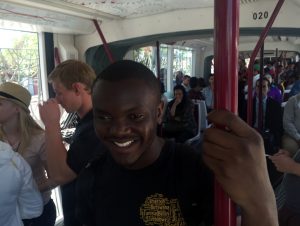 A positive image of sustainable development was captured on May 26 on our Rabat tramway excursion. The tram is a great public transportation option for Moroccans and tourists to get around the city. Most importantly, the tram has social and environmental benefits. Based off the picture, the tram is heavily utilized by people. There was not one time we entered the tram and it was empty. On the social aspect, people are able to strike up conversations with familiar friends and create new friends. As Moroccans are fairly warm people, they interact with each other a whole lot more. Conversations can be heard on various parts of the tram. As the tram is a non-polluting transport system, it has an environmental benefit. Overall, the tram was easy to use. We were able to purchase our tickets and insert it in the machine to validate it. With the validation, you are good to go on your trip. However, a mistake of not validating the ticket will cost approximately 50 Dirhams on the spot. This is a decent fine when compared to the fine of $50 – $500 on the Phoenix light rail. Overall, the tram seems to promote sustainable development in the public transportation sector.
A positive image of sustainable development was captured on May 26 on our Rabat tramway excursion. The tram is a great public transportation option for Moroccans and tourists to get around the city. Most importantly, the tram has social and environmental benefits. Based off the picture, the tram is heavily utilized by people. There was not one time we entered the tram and it was empty. On the social aspect, people are able to strike up conversations with familiar friends and create new friends. As Moroccans are fairly warm people, they interact with each other a whole lot more. Conversations can be heard on various parts of the tram. As the tram is a non-polluting transport system, it has an environmental benefit. Overall, the tram was easy to use. We were able to purchase our tickets and insert it in the machine to validate it. With the validation, you are good to go on your trip. However, a mistake of not validating the ticket will cost approximately 50 Dirhams on the spot. This is a decent fine when compared to the fine of $50 – $500 on the Phoenix light rail. Overall, the tram seems to promote sustainable development in the public transportation sector.
Sustainable
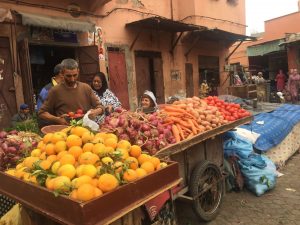 The Jemaa el Fna was an amazing adventure. The atmosphere is full of life with thousands of customers wandering around the merchants that are ready to sell customers their best products. In this image, the farmer is selling his crops such as tomatoes, onions and carrots. Through the research of my classmate Amanda, farmers usually follow organic methods to grow the crops they sell at the market. This local farmer takes great pride in growing and selling his own crops at the market. During my time in Morocco, I did not notice any produce that had a label that it was imported from America, Mexico or Europe. Actually, none of the fruits and vegetables I bought had a label on them. Overall, the Jemaa el Fna was a sustainable sight to see with all of the local farmers at the stands.
The Jemaa el Fna was an amazing adventure. The atmosphere is full of life with thousands of customers wandering around the merchants that are ready to sell customers their best products. In this image, the farmer is selling his crops such as tomatoes, onions and carrots. Through the research of my classmate Amanda, farmers usually follow organic methods to grow the crops they sell at the market. This local farmer takes great pride in growing and selling his own crops at the market. During my time in Morocco, I did not notice any produce that had a label that it was imported from America, Mexico or Europe. Actually, none of the fruits and vegetables I bought had a label on them. Overall, the Jemaa el Fna was a sustainable sight to see with all of the local farmers at the stands.
Unsustainable
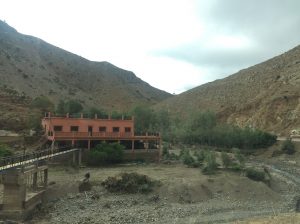 This picture was taken in Ouarzazate. Throughout the tour around Morocco, there were various locations with vast amounts of plastic bottles and bags on the ground. In this photo, the backyard of the home has a pile of plastic bottles on the corner of it. Unfortunately, there are plastic bottles near the creek as well. Dr. Ahmed Baroudi and the students emphasized the difficultly with a recycling club on campus due to the lack of recycling infrastructure. This difficulty can be seen in the picture as well. There aren’t any recycling bins on site for the resident to place recyclables in. On the brighter side, Mary Jane said the country has drastically reduced the amount of plastic objects in the environment. With King Mohammed’s huge push for human development, this will be a good start to educate and encourage people to “Reduce, Reuse, Recycle.” This picture shows that there is still work to be done to improve the recycling infrastructure.
This picture was taken in Ouarzazate. Throughout the tour around Morocco, there were various locations with vast amounts of plastic bottles and bags on the ground. In this photo, the backyard of the home has a pile of plastic bottles on the corner of it. Unfortunately, there are plastic bottles near the creek as well. Dr. Ahmed Baroudi and the students emphasized the difficultly with a recycling club on campus due to the lack of recycling infrastructure. This difficulty can be seen in the picture as well. There aren’t any recycling bins on site for the resident to place recyclables in. On the brighter side, Mary Jane said the country has drastically reduced the amount of plastic objects in the environment. With King Mohammed’s huge push for human development, this will be a good start to educate and encourage people to “Reduce, Reuse, Recycle.” This picture shows that there is still work to be done to improve the recycling infrastructure.
Unsustainable
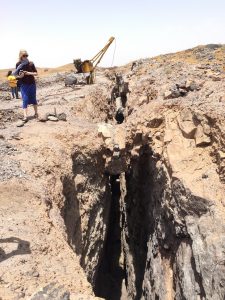 This picture was taken in Merzouga. One of the tour guides explained to us that this open-pit mine was built by the French many years ago. The precious minerals were extracted by the French who also created a type of settlement near by the mine. At the time, the area was filled with miners who lived in the settlement and worked at the mine. Once the operations were complete, the French literally just abandoned the mine. Based on the fact machinery is still there, the mine is still under operations today. But these operations are at a much smaller scale than before. Now, this open-pit mine poses various threats. My classmate in this picture was able to keep a good distance away from the opening of the pit but these open mines can cause injuries to a person that falls in it. Also, this open-pit mine poses health concerns. The tour guide did not mention if there were any toxins that are released from the mine but the mining process could have released heavy metals and dusts into the atmosphere or underground water. Unfortunately, the previous owners did not have the decency to close the pit as it seems like all of the worthy minerals have been extracted already. Overall, this image is really unsustainable.
This picture was taken in Merzouga. One of the tour guides explained to us that this open-pit mine was built by the French many years ago. The precious minerals were extracted by the French who also created a type of settlement near by the mine. At the time, the area was filled with miners who lived in the settlement and worked at the mine. Once the operations were complete, the French literally just abandoned the mine. Based on the fact machinery is still there, the mine is still under operations today. But these operations are at a much smaller scale than before. Now, this open-pit mine poses various threats. My classmate in this picture was able to keep a good distance away from the opening of the pit but these open mines can cause injuries to a person that falls in it. Also, this open-pit mine poses health concerns. The tour guide did not mention if there were any toxins that are released from the mine but the mining process could have released heavy metals and dusts into the atmosphere or underground water. Unfortunately, the previous owners did not have the decency to close the pit as it seems like all of the worthy minerals have been extracted already. Overall, this image is really unsustainable.
Unsustainable to Sustainable
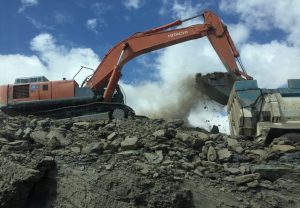 This picture is a perfect representation of the concept of development in Morocco. Morocco is in a stage of improving its road transportation system. The narrow roads on the High Atlas Mountains are in the process of expanding. From speaking with the MASEN representatives, multiple parabolic troughs were destroyed on the route to the NOOR 1 site as the narrow, winding roads were obstacles for these glass mirrors. There are many blind corners on this common route and it increases the risks of an accident to occur in this condition. The roads seem to be originally built for slow traffic and small vehicles. However, the increase of traffic on this route has created a sense of urgency for an expansion of these roads. From the first time I saw this, I did not agree in destroying the beautiful nature of the High Atlas Mountains to expand roads. But once I looked into the reasons, it made complete sense of these expansions. This process is natural for a developing country. In my case, it was the realization that we have chosen to build roads and highways for our benefit to travel and transport necessary goods in place of leaving nature the way it should be.
This picture is a perfect representation of the concept of development in Morocco. Morocco is in a stage of improving its road transportation system. The narrow roads on the High Atlas Mountains are in the process of expanding. From speaking with the MASEN representatives, multiple parabolic troughs were destroyed on the route to the NOOR 1 site as the narrow, winding roads were obstacles for these glass mirrors. There are many blind corners on this common route and it increases the risks of an accident to occur in this condition. The roads seem to be originally built for slow traffic and small vehicles. However, the increase of traffic on this route has created a sense of urgency for an expansion of these roads. From the first time I saw this, I did not agree in destroying the beautiful nature of the High Atlas Mountains to expand roads. But once I looked into the reasons, it made complete sense of these expansions. This process is natural for a developing country. In my case, it was the realization that we have chosen to build roads and highways for our benefit to travel and transport necessary goods in place of leaving nature the way it should be.

